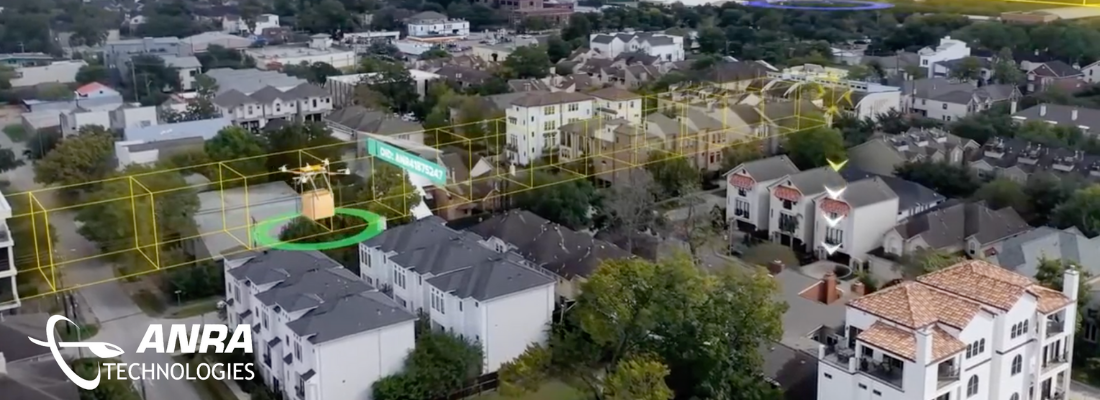“In any case, there will be an integrated airspace traffic management system and it will be able to function quite autonomously. To get there, different parties from the industry will have to keep working with each other,” says Amit Ganjoo, founder of ANRA Technologies, which in just 6 years has taken a leading position in the world of traffic management solutions.
Amit Ganjoo founded ANRA Technologies in 2015. And according to Ganjoo, ANRA is one of the first companies active in the airspace management business for unmanned traffic since the day the term UTM was coined. The company has a space act agreement with NASA and the only company that can claim to have participated in all of NASA's UTM national campaigns. Six years later, ANRA is operating globally and has offices in the US, UK and Asia.It is not so strange that Ganjoo would become active in the world of UAM. He started his career at Ericsson, ran his own company, worked as a contractor for the US Department of Defense in the field of drones and communications, learned to fly and even built his own experimental plane. “We are a company that builds the technology but also helps write the standards and regulations. We define the standards, we implement them and firmly believe in open standards and global harmonisation. This industry cannot scale by building be a one-off things. Everything in this new airspace management paradigm needs to be harmonised. In a few years from now you will have a transborder operation and much much more.
Differences
ANRA Technologies is probably one of the few companies that works with NASA as well as for the European SESAR project. Ganjoo knows better than anyone the differences in approach between Europe and the US. 'At a 10-thousand foot level, the differences are few. But the regulations that cover the technology, as it were, differ in Europe, the US and Asia. But on a conceptual level, we try to solve the same technical problems everywhere. And that is why we must focus on standards and interfaces that can be used worldwide.'
Although nothing is perfect and there will always be room for improvement, Ganjoo does have his ideas about an ideal UTM system. “But that will develop gradually and evolutionarily. We'll start with something, try it out in real world, we'll realize that some things will work, but some things also need to be adjusted. I don't think the systems we're imagining now will be around in 15 years. Ultimately, a completely integrated airspace management will be created: manned or unmanned. Or crewed or uncrewed in the new terminology. They are all going to interoperate: all sizes and all shapes. In our internal briefings we call it airspace management plus plus. And it’s going to be a combination of what UTM or UAM air space management brings, what the legacy ATM brings and there will be ties between the two and some new additions that will be required. The system has to be more automated because having that legacy concept of a human always in the loop is not scalable when the number of aircraft increases. So it has to be human on the loop versus human in the loop. As we move forward we need more automation, more machine learning, more AI.”
Monetise
Ganjoo is not afraid that the industry and the market cannot keep up with such a comprehensive system. “Technology always leads regulation. I don't think the problem will be on the technology side. Regulations are lagging. But they are catching up. Hopefully that gap narrows as we move forward.”
And it's not just about regulation. Ganjoo cites business models as the next obstacle. “It depends on where in the world you are, but the differences between Air Navigation Service Providers (ANSPs) are huge. Who will be able to earn money with this new form of air traffic navigation? Because at the end of the day it's the same air space and you need to create equitable access. But someone has to manage and monetise it to ensure and sustain the technology, the framework and the infrastructure.”
Last March CANSO invited more than 20 organisations from around the globe for what was named the Complete Air Traffic System (CATS) Global Council. The outcome of the Council should be a blueprint for future skies. Ganjoo is enthusiastic about the initiative. “It will have to be done in small steps. Because you can't eat an elephant all at once. What certainly helps is the collaborative nature of the Council. The industry works together with governments and regulators. That's what a young industry like ours needs. I like to call it ‘coopetition': you have to cooperate before you compete. If we don't cooperate today, there won't be an industry to compete in down the line."
Anra Technologies at the AAM Summit in Las Vegas
Amit Ganjoo will be speaking during the AAM Summit in Las Vegas 9 September 2021 on the mobility needs for future cities. Advanced Air Mobility (AAM) represents the evolution of Urban Air Mobility (UAM), which is a concept that will revolutionize air travel for consumers everywhere. This evolution is connected to the future of the sky as a whole where unmanned vehicles of all sizes will be sharing the same airspace. We’ll address the technological progress being made in this area along with an update on the policy and regulatory advancements that are in the works. View the programme here.






